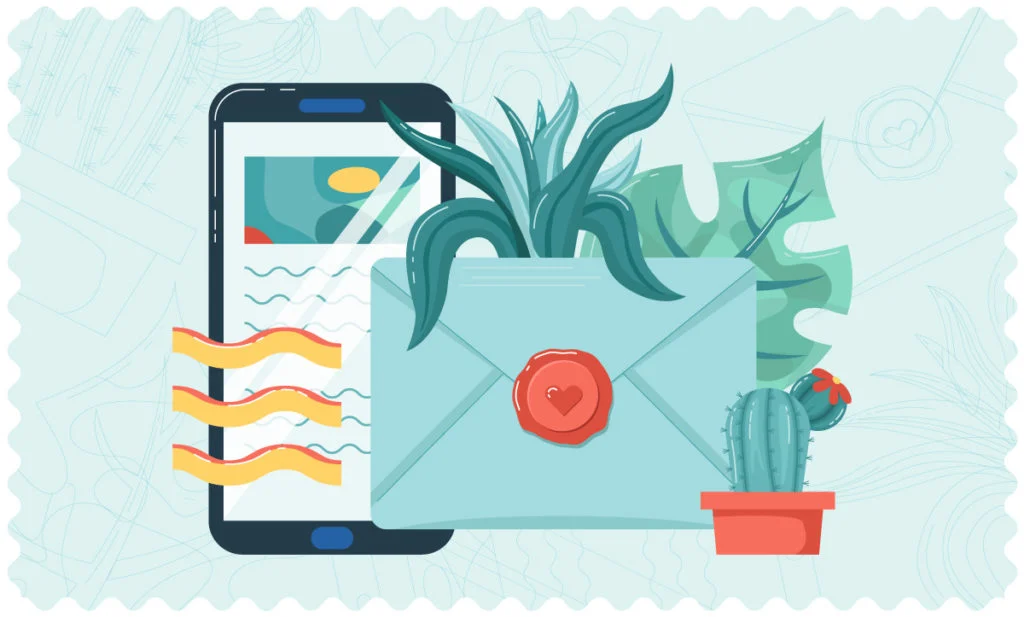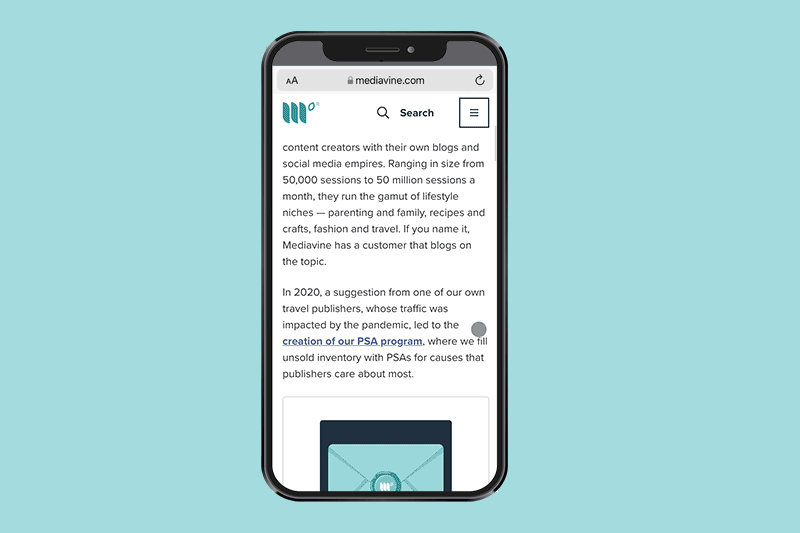Email Marketing Essentials for Creators


You’ve got tons of people coming to your blog to grab a recipe, learn how to make faux board and batten, or find the best food to eat on their vacation to Venice. Way to go!
This is great because:
But do you know who they are? Wouldn’t it be great if you could keep bringing those visitors back, over and over again, and direct them to the exact content they want to consume?
Email marketing is one of the best ways to do just that.
If you’re new to email marketing, this post is for you. To help you succeed with email marketing, we’ve put together a guide to getting started.
Hi! I’m Brandon. I am a senior marketing manager at Mediavine, focused on helping our awesome publisher community understand the importance of email marketing and how to do it well.
For nearly two decades, I have been doing email marketing for mid-sized companies in the tech and retail industries, including seven years with AWeber, one of the most well-known email service providers in the world.
I have helped hundreds of creators and small business owners improve their email marketing skills and strategies, and I am excited to share this knowledge and experience with you.

Let’s start with understanding the importance of email marketing. Here are just a handful of reasons why you could consider using email marketing to connect with your audience:
For starters, nearly everyone on the planet has an email address, and nearly everyone on the planet checks their inbox every day, sometimes multiple times per day (or even every hour, like me!).
As Ann Handley once said, “Email is the only place where people (not algorithms) are in control.” ( Content Marketing World 2018) Unlike Google search and social media, with email there’s no need to rely on algorithms for your content to be seen.
Just like your website and all the content you produce, your email list is something you own. Don’t like your provider? No problem! You can pick up your email list and take it somewhere else.
One of the greatest benefits of email marketing is its ability to drive direct traffic to your blog or website, social media content, videos and more. And when your audience is logged in to Grow, Mediavine’s first-party data solution, that is authenticated traffic you can monetize (if you are running Grow and advertising with Mediavine)!
Email can be very personal, like writing a letter to a friend. It’s one of the best ways to have one-on-one conversations with individuals at scale. It’s a way to stay in touch with your most engaged readers — those who want to hear from you.
Email is also very measurable. You can see the direct results of each email you send. For example, you could send 100 emails, get 20 people to click through to your content, and see five people buy something from your site.
So how can you get started?

Strategy? I know, creating a strategy sounds pretty daunting, but it’s much easier than you might think.
One of the easiest ways to create a strategy is by answering who, what, when and why.
Are you looking to build an engaged audience, drive more traffic to your blog or social media content or make more sales? All of the above? Understanding why you want to send emails will help you focus your efforts and be more efficient with your emails.
People looking for cookie recipes only? Anyone who signs up?
Recent posts from your blog? Exclusive content for just your email readers? Stories? Tips and tricks?
How often do you want to send emails? Daily, weekly, monthly?
Taking the time to write out a simple strategy will go a long way to helping you achieve success with your email marketing quickly.
With a strategy in hand, now it’s time to select the right email service provider. There are dozens of providers on the market (e.g., ConvertKit, Mailchimp, MailerLite, AWeber), all with very similar features and functionality.
If you’re just starting out with email marketing, Mediavine has the perfect solution for you: Grow Automailer. It’s completely free with a Grow Publisher account.
With Grow Automailer, you can set your email marketing on autopilot. Once set up, it automatically sends a weekly email digest of your content, tailored to each subscriber based on their preferences and activity on your site – the right content for the right audience.
Before you can start sending emails to your audience, you’ll need to collect email addresses, of course.
To do this, you’ll simply add an email subscribe form to your website so visitors can sign up to receive emails from you.
Looking for an easy way to add signup forms to your site and grow your email list? Try Mediavine’s Grow Subscribe Forms, an easy way to not only build an email list but also authenticate users and gather first-party data, which will be key for ad monetization.
Pro Tip: Mediavine has ad monetization solutions for any size site. Just starting out and have less than 50,000 sessions? Apply for Journey by Mediavine. Have more than 50,000 sessions? Apply for Mediavine.

Grow Subscribe Forms allow you to add email subscribers to your weekly Grow Automailer or connect directly to some of the most popular email service providers, including ConvertKit, Mailchimp and MailerLite, as well as others using Zapier.
Grow Subscribe Forms offer a variety of placement options, including:
Simply pick the one you like, customize it to fit your brand, and publish it to your site.
These forms can be added across your entire site, or you can use Category Targeting to show specific forms for each category on your site. This makes it easy to swap out opt-in forms for seasonal content all at once rather than having to manually replace signup forms on various pages.
Additionally, you can help grow (see what I did there?) your email list using Exclusive Content — a feature that allows you to lock specific articles, recipes, images, printables, etc. behind a Grow login page, as well as adding the subscriber to your email list.
Of course, readers aren’t simply going to subscribe to your email list just because you ask them to. You need to offer some sort of incentive.
Incentives come in all sorts of formats, so pick the one(s) that work best for you and your website. Here are some to get those creative juices flowing:
Once subscribers start signing up, it’s time to create and send them emails.
The first thing to consider is using an email address from your own domain, not a free domain (e.g., gmail, hotmail, yahoo, etc.). This is super important if you want your emails to actually reach your subscribers as these email clients can penalize you for using free email addresses.
Next, you’ll need to design an email template. Many email marketing softwares have templates you can customize with your own branding and colors.
If you’re using Grow Automailer, you can customize your email template by adding your logo and adjusting the link color to match your site.
With your template ready, now it’s time to start crafting your emails.
Be sure to test and review your emails for typos and broken links.
Not sure when to send your emails? This varies by audience, but typically Tuesday, Wednesday or Thursday work best. But feel free to test different days and times to see which works best for your audience. (Note: If you’re using Automailer, it will choose the weekly send day for you.)
A key to any successful email marketing plan is reviewing the performance of your emails, identifying what’s working and what isn’t and improving your emails over time.
Look at open rates, click-through rates, deliverability rates and unsubscribe rates.
As a general rule, you should shoot for an open rate of at least 20% and a click-through rate of at least 5%.
Caveat: Open rates are not an accurate view of who is actually opening your emails. Email service providers track whether someone has opened an email by using a tiny image that loads once the email is opened. If a subscriber has disabled images in their email client (e.g. Gmail), the email service provider won’t be able to track that as an open.
A better measurement to look at is how many people are engaging with your email content by clicking links (i.e., click-through rate) or replying to your emails.

Want to get your audience repeatedly coming back to your website for more content? Email marketing is one of the best ways to do it.
Follow the steps outlined in this article to get started with email marketing.
When you’re ready to start monetizing your site, apply for the Mediavine ad management solution that fits your needs, whether that’s Mediavine or Journey by Mediavine.
Stay up to date with the latest from Mediavine
 Eric Hochberger
Eric Hochberger
For the past year, Google has been experimenting with a feature called Recipe Quick View – a feature allowing users to click an icon inside search results to view an …
 Eric Hochberger
Eric Hochberger
By now, we’re all aware that generative AI is dramatically changing the web, leaving content creators — whose work is used to train powerful AI models — under duress. But …